
Orb-weaver spiders are members of the spider family Araneidae. They are the most common group of builders of spiral wheel-shaped webs often found in gardens, fields, and forests. The English word "orb" can mean "circular", hence the English name of the group. Araneids have eight similar eyes, hairy or spiny legs, and no stridulating organs.

Philoponella is a genus of uloborid spiders. Like all Uloboridae, these species have no venom.
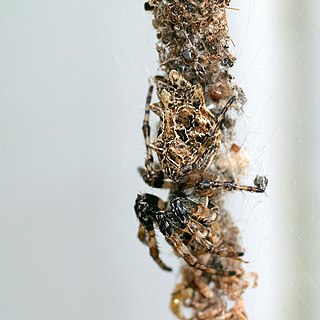
Cyclosa, also called trashline orbweavers, is a genus of orb-weaver spiders first described by Anton Menge in 1866. Widely distributed worldwide, spiders of the genus Cyclosa build relatively small orb webs with a web decoration. The web decoration in Cyclosa spiders is often linear and includes prey remains and other debris, which probably serve to camouflage the spider. The name "Cyclosa" comes from Greek 'to move in a circle', referring to how it spins its web.

Micrathena, known as spiny orbweavers, is a genus of orb-weaver spiders first described by Carl Jakob Sundevall in 1833. Micrathena contains more than a hundred species, most of them Neotropical woodland-dwelling species. The name is derived from the Greek "micro", meaning "small", and the goddess Athena.
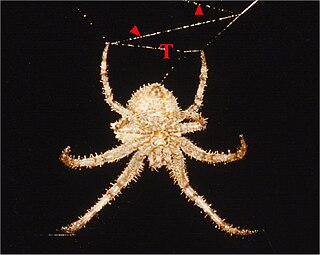
Kaira, sometimes called frilled orbweavers, is a mostly neotropical genus of orb-weaver spiders first described by O. Pickard-Cambridge in 1889. It includes sixteen described species that occur from South America up to the southern and eastern USA. It is presumably related to Aculepeira, Amazonepeira and Metepeira.

Acacesia is a genus of orb-weaver spiders first described by Eugène Simon in 1895. It contains six species with a mostly neotropical distribution, ranging from South America to Mexico. One species, A. hamata, is found in the US as well.

Metepeira is a genus of orb-weaver spiders first described by F. O. Pickard-Cambridge in 1903. The name is derived from the Ancient Greek μετά and the obsolete genus name Epeira, denoting a genus similar to Epeira.

Larinia is a genus of orb-weaver spiders first described by Eugène Simon in 1874.
Testudinaria is a genus of orb-weaver spiders first described by Władysław Taczanowski in 1879.

Glenognatha is a genus of long-jawed orb-weavers that was first described by Eugène Louis Simon in 1887. It was considerably revised in 2016.

Mangora is a genus of orb-weaver spiders first described by O. Pickard-Cambridge in 1889.
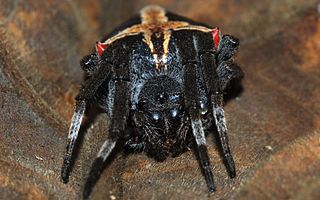
Parawixia is a genus of orb-weaver spiders first described by F. O. Pickard-Cambridge in 1904. Most species are found in the Neotropics but one species, Parawixia dehaani, is found in Australasia and tropical Asia as far west as India.
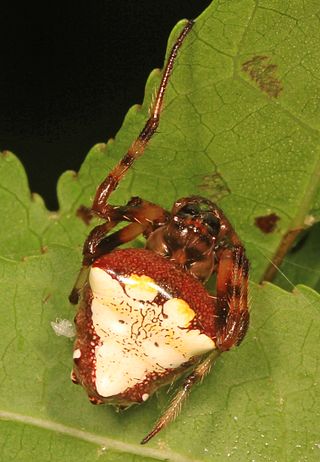
Verrucosa is a genus of orb-weaver spiders first described by Henry McCook in 1888. It contains almost fifty described species, most of which live in South America. The only species in the United States is the arrowhead spider.

Mecynogea is a genus of orb-weaver spiders first described by Eugène Simon in 1903. The name is derived from the Greek mekyno (μηυνω), meaning "to lengthen", and "gea" (γεα), meaning "earth".
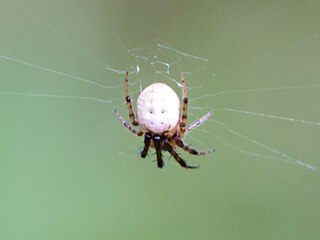
Metazygia is a genus of orb-weaver spiders first described by F. O. Pickard-Cambridge in 1904. They physically resemble members of Nuctenea, but they do not have fine setae on the carapace.

Wagneriana is a genus of orb-weaver spiders first described by F. O. Pickard-Cambridge in 1904.
Xylethrus is a genus of Central and South American orb-weaver spiders first described by Eugène Simon in 1895.

Thymoites is a genus of comb-footed spiders that was first described by Eugen von Keyserling in 1884.

Alpaida is a genus of South American orb-weaver spiders first described by Octavius Pickard-Cambridge in 1889.
















